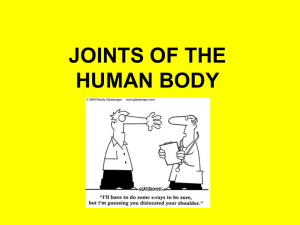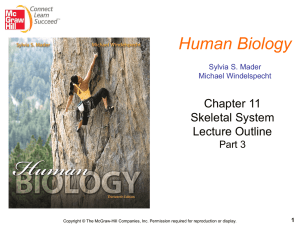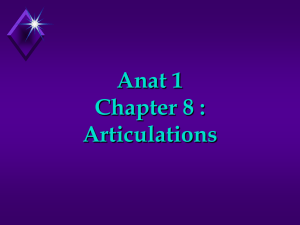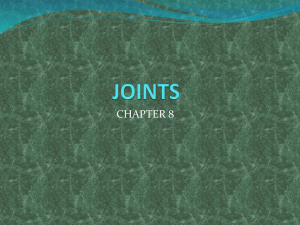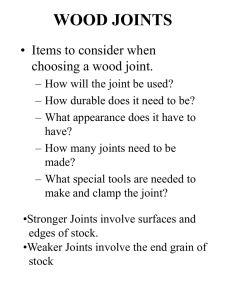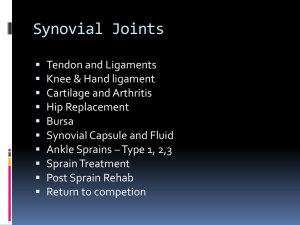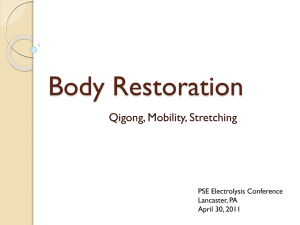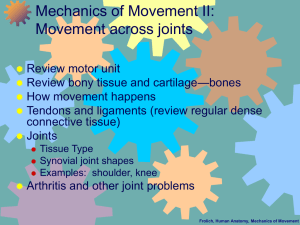Joints
advertisement
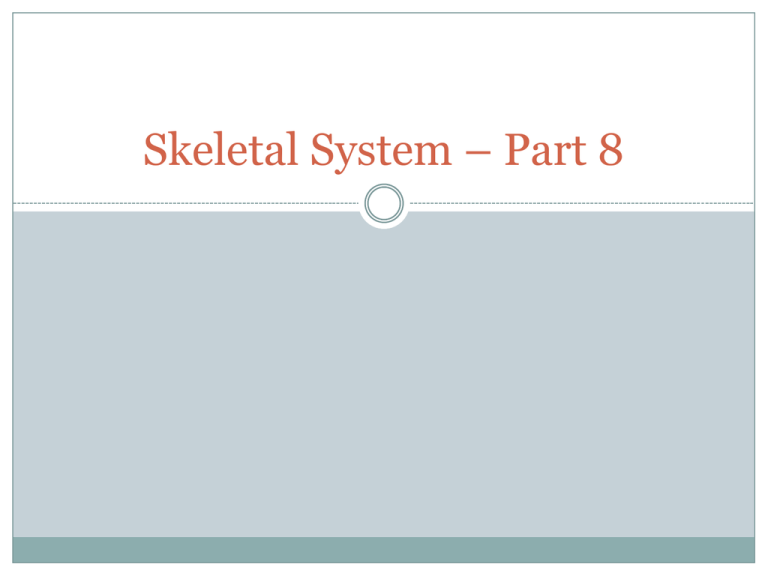
Skeletal System – Part 8 Joints Every bone in the body (except the hyoid bone of the neck) forms a joint with at least one other bone. Joints (Articulations) – Sites where two or more bones meet. Functions of Joints Joints have two functions: 1. Hold the bones together securely 2. Give the rigid skeleton mobility Joints are classified in two ways: 1. Functionally (focuses on the amount of movement allowed by the joint) 2. Structurally Functional Classification of Joints 1. Synarthroses: Immoveable joints; Allows no movement. - Example: Bones in the skull 2. Amphiarthroses – Slightly moveable joints; Allow a small amount of restricted movement. - Example: Vertebrae and the joints between the two bones of the lower leg. 3. Diarthroses - Freely Moveable; Permit movement in one or more directions - Example: Shoulder, neck, and knee Structural Classification of Joints Structurally, there are three types of joints: 1. 2. 3. Fibrous Joints Cartilagenous Joints Synovial Joints Fibrous Joints Fibrous Joints – The bones are united by fibrous tissue; As a general rule, these are immoveable. Bones are bound tightly together by CT fibers, allowing essentially no movement. Example: Sutures of the skull. Cartilagenous Joints Cartilagenous Joints – Bone ends are connected by cartilage. Cartilagenous Joints Slightly Moveable Examples: Pubic symphysis of the pelvis Intervertebral joints of the spinal column (connected by discs of fibrocartilage) Most cartilagenous joints are slightly moveable Immoveable Examples: The Epiphyseal plates of growing long bones Joints between the first ribs and the sternum. Synovial Joints Synovial Joints – Joints in which the articulating bone ends are separated by a joint cavity containing synovial fluid. All synovial joints have four distinguishing characteristics: 1. Articular cartilage Covers the ends of the bones forming the joint. 2. Fibrous articular capsule Joint surfaces are enclosed by a sleeve or capsule of fibrous CT The capsule is lined with a smooth synovial membrane (the reason these joints are called synovial joints). All synovial joints have four distinguishing characteristics (continued): 3. Joint cavity The articular capsule encloses a cavity, called the joint cavity, which contains lubricating synovial fluid. 4. Reinforcing ligaments The fibrous capsule is usually reinforced with ligaments. Bursae Bursae are often found closely associated with synovial joints. Bursae – Flattened fibrous sacs lined with synovial membrane and containing a thin film of synovial fluid. Common where ligaments, muscles, skin, tendons, or bones rub together. Tendon Sheaths Tendon sheaths are often found closely associated with synovial joints. Tendon Sheath – An elongated bursae that wraps completely around a tendon subjected to friction. Like a bun around a hot dog. Types of Synovial Joints: Based on Shape 1. Plane 2. Hinge 3. Pivot 4. Condyloid 5. Saddle 6. Ball-and- socket Plane Joint Plane Joint – The articular surfaces are essentially flat, and only short slipping or gliding movements are allowed. Movements are nonaxial (does not involve rotation around any axis). Examples: Intercarpal joints of the wrist. Hinge Joint Hinge Joint – The cylindrical end of one bone fits into a trough-shaped surface on another bone. Angular movement is allowed in just one plane, like a mechanical hinge. Classified as uniaxial (they allow movement around one axis only). Examples: elbow joint, ankle joint, and the joints between the phalanges of the fingers. Pivot Joint Pivot Joint – The rounded end of one bone fits into a sleeve or ring of bone. Because the rotating bone can turn only around its long axis, pivot joints are also uniaxial joints. Examples: Proximal radioulnar joint Joint between the atlas and the dens of the axis Condyloid Joint Condyloid Joint – The egg-shaped articular surface of one bone fits into an oval concavity in another. Both of these articular surfaces are oval. Allow the moving joint to travel (1) from side to side and (2) back and forth. But the bone cannot rotate around its long axis. Movement occurs around two axes, hence these joints are biaxial. Saddle Joint Saddle Joint – Each articular surface has both convex and concave areas, like a saddle. These biaxial joints allow essentially the same movements as condyloid joints. Example: Carpometacarpal joints in the thumbs Ball-and-Socket Joint Ball-and-Socket Joint – The spherical head of one bone fits into a round socket in another. These multiaxial joints allow movement in all axes, including rotation and are the most freely moving synovial joints. Examples: Shoulder and hip Dislocations A dislocation happens when a bone is forced out of its normal position in the joint cavity. Reduction – The process of returning the bone to its proper position. Should be done only by a physician. Attempts by an untrained person to “snap the bone back into its socket” are usually more harmful than helpful. Sprains Sprains – The ligaments or tendons reinforcing a joint are damaged by excessive stretching, or they are torn away from the bone. Since tendons and ligaments get poor blood supply, sprains heal slowly and are extremely painful.


